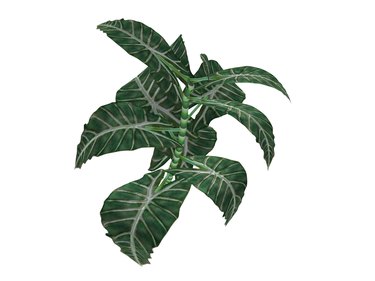Things You'll Need
Distilled or rainwater (optional)
Shallow tray
Pebbles
Water-soluble 15-15-15 fertilizer
Ready-to-use insecticidal soap (optional)
Pruners

Dramatic leaf shape and coloration make compact alocasia "Polly" (Alocasia x amazonica "Polly") a striking tropical accent for lightly shaded gardens in U.S. Department of Agriculture plant hardiness zones 10 through 11. Elsewhere, the glossy, white-veined, burgundy-backed green leaves provide exotic flair indoors. Before adopting a "Polly" plant -- commonly known as African mask or elephant's ears -- however, consider whether you have time to cater to its specific requirements. More important, weigh the risks to your family or pets. All of "Polly's" parts are potentially fatal when ingested and cause severe skin irritation on contact.
Step 1
Saturate "Polly's" soil or growing medium whenever its surface feels dry. Large, densely leaved plants need more water than small ones. Expect to water much more in spring and summer than during the fall-and-winter dormancy, when water loss through leaf transpiration dwindles. The chemicals in tap water may brown the leaf tips, so use rain- or distilled water if possible.
Video of the Day
Step 2
Recreate indoors the humid tropical habitat that "Polly" likes by setting its container on a tray of wet pebbles. Add water as needed to keep the pebbles submerged. A humidity level of 50 percent or higher is best, according to Logee's Tropical Plants.
Step 3
Feed every two months during spring and summer. Use a water-soluble, 15-15-15 fertilizer mixed at the rate of 3/8 teaspoon, or one-quarter the label's recommended strength, per 1 gallon of water. Apply after watering and discontinue feeding during dormancy.
Step 4
Maintain indoor "Polly" at 70 to 80 degrees Fahrenheit during the day, with overnight temperatures in the low 60s. Keep it away from cold or hot drafts.
Step 5
Watch for signs of root-rot infection, including pale leaves and wilting even in wet soil or medium. Root rot targets overwatered plants in excessively cool, humid environments. Discard a wilting plant and move a discolored one to a warmer, drier area. If "Polly's" pot is draining properly, turn it on its side and tap it to create spaces for oxygen around the roots and speed drying time. Delay watering until the medium's surface is dry, and feeding until new growth appears. Treating an infected in-ground plant may require lifting and potting for removal to a dry location.
Step 6
Check for spider mite webs on the undersides of the leaves. Treat an infestation with ready-to-use insecticidal soap; it's safe for indoor and outdoor use. Spray until it drips from all the plant's surfaces. Repeat every one to two weeks, or at the manufacturer's specified rate, until the pests are gone. Wear protective clothing and eyewear and follow the label directions when working with any insecticide.
Step 7
Prune dead foliage using hand-held pruners. Snip the dead leaf from the plant where it's connected to the main stem. Sterilize your pruning tool blades by wiping them off with alcohol between cuts and allowing the blades to dry before using.
Tip
Indoor African masks do best in bright light away from direct sun, such as that close to a south-facing window. The best spot for an outdoor "Polly" has filtered sunlight to partial shade and sheltered from heavy winds in a frost-free environment. It prefers soils that are rich in organic matter and retain moisture with a pH level between 5.6 and 7.5. Water regularly to keep the soil moist. Space multiple plants 15 to 18 inches apart and prune dead foliage with sanitized pruning tools. Use the same method of fertilization and pest control for indoor-grown plants.
Video of the Day
- Zipcodezoo: A. x Amazonica "Polly"
- Wedgewood Gardens: Instructions: Caring for Alocasia Polly (Alocasia Amazonica)
- University of California: Safe and Poisonous Garden Plants
- Logee's Tropical Plants: Cultural Information -- Alocasia
- Metropolitan Wholesalers: Alocasia Care Instructions
- Proven Winners: Wait, That Plant Is Drowning!
- Enlightened Orchids: Pest Control
- Viviano Flower Shop: Alocasia Polly
- University of Florida IFAS Extension: Alocasia Spp. Elephants Ear